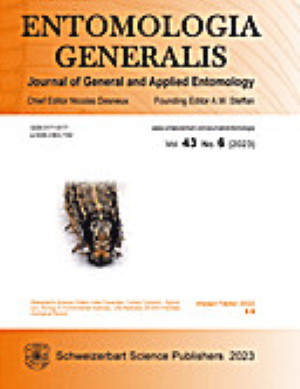Ultraviolet and violet light enhance the attraction efficacy of semiochemicals for the Asian longhorned beetle
IF 4.6
1区 农林科学
Q1 ENTOMOLOGY
引用次数: 0
Abstract
The Asian longhorned beetle Anoplophora glabripennis attacks healthy trees and semiochemicals are used for monitoring, although no optimal efficacy has been achieved. To develop monitoring strategies, we compared the attraction rates of 14 monochromatic light-emitting diodes (LEDs) for A. glabripennis adults, and determined the relative attraction capacity of most attractive wavelengths: the attraction rates were higher at 365-nm and 420-nm than other wavelengths. Subsequently, we evaluated whether 365-nm and 420-nm lights could enhance the attraction rates of sex pheromones or host kairomone, alone or in combination. We assessed the attraction rates of combinations of LEDs and sex pheromones or host kairomones, and showed that attraction rates of combinations of light cues and [4-(n-heptyloxy) butanol and 4-(n-heptyloxy) butanal], (Z)-3-hexen-1-ol, (Z)-3-hexenol acetate or (-)-linalool were higher than those of single chemicals. Finally, we studied the influence of LED light, sex pheromones and host kairomone mixtures on attraction for A. glabripennis and found that combinations of cues attracted were more attractive than LED cues or semiochemicals alone. When 420-nm light was combined with mixtures of [4-(n-heptyloxy) butanol:4-(n-heptyloxy) butanal:(-)-linalool = 1:1:1], the attraction rates for adult females increased by 212% (vs. LED cues alone) and by 5321% (vs. semiochemicals alone). We demonstrated that ultraviolet and violet lights could enhance the attraction efficacy of semiochemicals for A. glabripennis and combination cues provided a promising strategy.紫外线和紫光可增强半化学物质对亚洲长角金龟子的引诱效果
亚洲长角金龟子会攻击健康的树木,我们使用半化学物质进行监测,但尚未取得最佳效果。为了制定监测策略,我们比较了 14 种单色发光二极管(LED)对亚洲长角金龟子成虫的吸引率,并确定了最具吸引力波长的相对吸引能力:365 纳米和 420 纳米的吸引率高于其他波长。随后,我们评估了 365 波长和 420 波长的光是否能单独或联合提高性信息素或宿主凯氏酮的吸引率。我们评估了 LED 与性信息素或宿主凯尔酮组合的吸引率,结果表明光线索与[4-(正庚氧基)丁醇和 4-(正庚氧基)丁醛]、(Z)-3-己烯-1-醇、(Z)-3-己烯醇醋酸酯或(-)-芳樟醇组合的吸引率高于单一化学物质的吸引率。最后,我们研究了 LED 光、性信息素和宿主凯洛蒙混合物对草履虫吸引力的影响,发现引诱线索的组合比单独的 LED 线索或半化学物质更有吸引力。当 420nm 光与[4-(正庚氧基)丁醇:4-(正庚氧基)丁醛:(-)-芳樟醇 = 1:1:1]混合物结合使用时,成年雌虫的吸引率提高了 212%(与单独使用 LED 提示物相比)和 5321%(与单独使用半化学物质相比)。我们证明,紫外线和紫光可以提高半化学物质对草履虫的吸引效果,而组合线索则是一种很有前景的策略。
本文章由计算机程序翻译,如有差异,请以英文原文为准。
求助全文
约1分钟内获得全文
求助全文
来源期刊

Entomologia Generalis
生物-昆虫学
CiteScore
7.10
自引率
18.80%
发文量
72
审稿时长
>12 weeks
期刊介绍:
Its scope covers all aspects of basic and applied research dealing with insects and more broadly with arthropods inhabiting wild, agricultural and/or urban habitats. The journal also considers research integrating various disciplines and issues within the broad field of entomology and ecology.
Entomologia Generalis publishes high quality research articles on advances in knowledge on the ecology and biology of arthropods, as well as on their importance for key ecosystems services, e.g. as biological control and pollination. The journal devotes special attention to contributions providing significant advances (i) on the fundamental knowledge and on sustainable control strategies of arthropod pests (including of stored products) and vectors of diseases, (ii) on the biology and ecology of beneficial arthropods, (iii) on the spread and impact of invasive pests, and (iv) on potential side effects of pest management methods.
Entomologia Generalis welcomes review articles on significant developments in the field of entomology. These are usually invited by the editorial board, but proposals may be sent to the Editor-in-Chief for preliminary assessment by the editorial board before formal submission to the journal. The journal also considers comments on papers published in Entomologia Generalis, as well as short notes on topics that are of broader interest.
 求助内容:
求助内容: 应助结果提醒方式:
应助结果提醒方式:


